Attached files
| file | filename |
|---|---|
| 8-K - FORM 8-K - ORRSTOWN FINANCIAL SERVICES INC | d534170d8k.htm |
 Investor Presentation
May
2013
Orrstown Financial Services, Inc.
Exhibit 99 |
 2
This
presentation
may
contain
forward-looking
statements
as
defined
in
the
Private
Securities
Litigation
Reform
Act
of
1995.
Forward-
looking
statements
are
statements
that
include
projections,
predictions,
expectations,
or
beliefs
about
events
or
results
or
otherwise
are
not
statements
of
historical
facts,
including
statements
related
to
improving
credit,
improving
core
fundamental
operations,
improving
operational
efficiency,
cost
savings,
growing
core
earnings
through
expense
reduction
and
revenue
growth,
investments
in
revenue
generating
lines
of
business,
preserving
capital,
serving
shareholder
returns,
expanding
core
funding,
converting
non-performing
assets
to
earning
assets,
being
well
positioned
for
selective
loan
growth,
our
target
efficiency
ratio
in
the
next
36
months,
our
initiatives
meeting
return
on
capital
minimums,
and
strong
reserve
coverage.
Actual
results
and
trends
could
differ
materially
from
those
set
forth
in
such
statements
and
there
can
be
no
assurances
we
will:
improve
credit,
improve
core
fundamental
operations,
improve
operational
efficiency,
achieve
cost
savings,
grow
core
earnings,
grow
our
revenues,
reduce
expenses,
expand
our
business,
preserve
capital,
provide
the
return
that
our
shareholders
may
expect,
expand
core
funding,
convert
non-performing
assets
to
earning
assets,
grow
our
loan
portfolio,
achieve
our
target
efficiency
ratio
in
the
next
36
months,
or
that
our
initiatives
will
meet
return
on
capital
minimums
or
that
our
reserves
will
be
adequate.
Factors
that
could
cause
actual
results
to
differ
from
those
expressed
or
implied
by
the
forward-looking
statements
include,
but
are
not
limited
to,
the
following:
ineffectiveness
of
the
Company's
business
strategy
due
to
changes
in
current
or
future
market
conditions;
the
effects
of
competition,
including
industry
consolidation
and
development
of
competing
financial
products
and
services;
changes
in
laws
and
regulations,
including
the
Dodd-Frank
Wall
Street
Reform
and
Consumer
Protection
Act;
interest
rate
movements;
changes
in
credit
quality;
inability
to
raise
capital
under
favorable
conditions,
volatilities
in
the
securities
markets,
deteriorating
economic
conditions,
and
other
risks
and
uncertainties,
including
those
detailed
in
Orrstown
Financial
Services,
Inc.'s
Form
10-K
for
the
fiscal
year
ended
December
31,
2012
and
2011
and
Form
10-Qs
for
the
quarters
ended
March
31,
2012,
June
30,
2012,
September
30,
2012
and
March
31,
2013,
and
other
filings
made
with
the
Securities
and
Exchange
Commission.
The
statements
are
valid
only
as
of
the
date
hereof
and
Orrstown
Financial
Services,
Inc.
disclaims
any
obligation
to
update
this
information.
Forward Looking Information |
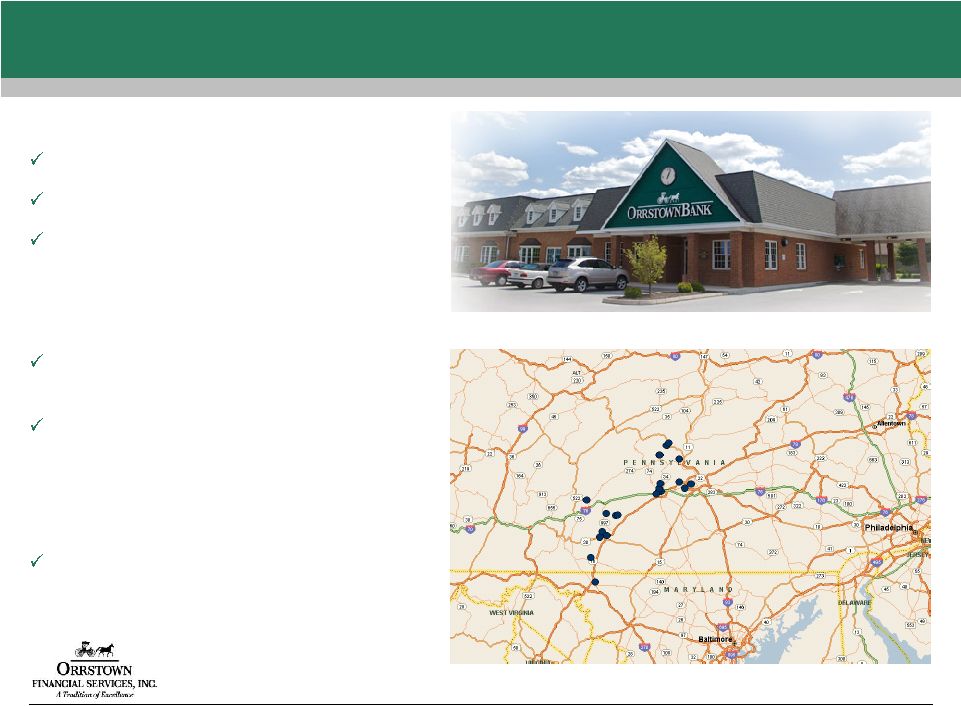 3
Orrstown Financial Services, Inc.
$1.2 billion in assets
Headquartered in Shippensburg, PA
21 locations in Pennsylvania and Maryland
•
9 branches in Cumberland
•
7 branches in Franklin
•
4 branches in Perry
•
1 branch in Washington
Customer-focused business model with
nearly 100 years of success
In addition to community banking
services, provides trust & investment
services to individuals, businesses, non-
profits and municipalities (over $1 billion
of trust assets as of March 31, 2013)
Trades on the NASDAQ under the symbol
“ORRF” |
 4
Seasoned Leadership Team
Thomas
R.
Quinn,
Jr.
has
served
as
President,
Chief
Executive
Officer
and
Director
of
Orrstown
Financial
Services,
Inc.
and
of
Orrstown
Bank
since
May
2009.
Mr.
Quinn
joined
the
Bank
in
March
2009
as
President-elect
and
served
in
that
capacity
until
he
was
appointed
President
and
Chief
Executive
Officer.
He
served
as
President
and
Chief
Executive
Officer
of
Fifth
Third
Bancorp’s
South
Florida
Affiliate
from
2005
to
July
2008,
and
in
a
variety
of
executive
positions
with
Citigroup
and
its
affiliates
from
1992
to
2005.
Mr.
Quinn
is
a
graduate
of
Edinboro
University
of
Pennsylvania.
Thomas R. Quinn Jr.
President & CEO
David
P.
Boyle
has
served
as
Executive
Vice
President
and
Chief
Financial
Officer
of
Orrstown
Financial
Services,
Inc.
and
Orrstown
Bank
since
August
2012.
Mr.
Boyle
graduated
from
Westminster
College
with
a
degree
in
Business
Administration
and
Accounting.
Mr.
Boyle
worked
as
an
Accountant
for
four
years
at
a
Big
Four
accounting
firm
following
graduation
before
entering
the
banking
field
in
1990
as
Vice
President,
Controller
at
Wayne
Bancorp,
Inc.,
in
Wooster,
Ohio.
As
his
career
progressed
at
Wayne
Bancorp,
Inc.,
Mr.
Boyle
was
named
Chief
Financial
Officer
in
1995;
President,
Chief
Operating
Officer
in
1999;
and
Chairman,
President
and
Chief
Executive
Officer
in
2001.
His
most
recent
position
was
Executive
Vice
President,
Chief
Performance
Officer
at
PNC.
David P. Boyle
Executive VP & CFO
Jeffrey
M.
Seibert
began
as
a
Management
Trainee
and
progressed
through
roles
of
increasing
responsibility
prior
to
joining
Peoples
State
Bank
("Peoples")
in
1994.
He
worked
for
Peoples,
and
its
successor,
Community
Banks
of
Harrisburg
as
Senior
Lender,
Chief
Credit
Officer,
and
Managing
Director
of
Banking
Services.
Mr.
Seibert
served
as
Chief
Operating
Officer
of
Susquehanna
Bank,
PA,
Managing
Director
of
Commercial
Banking,
and
finally
President
of
the
Pennsylvania
Division.
Jeffrey M. Seibert
EVP & COO
Years Experience
Previous Experience
23 Years
22 Years
David D. Keim
Executive VP & Chief
Risk Officer
David
D.
Keim
oversees
the
Enterprise
Risk
Management
function
of
the
Bank
and
is
responsible
for
the
leadership,
innovation,
governance,
and
management
necessary
to
identify,
evaluate,
mitigate,
and
monitor
the
Bank's
operational
and
strategic
risk.
A
graduate
of
Drexel
University
and
the
Stonier
Graduate
School
of
Banking,
Mr.
Keim
spent
the
majority
of
his
career
in
south
central
Pennsylvania
at
Susquehanna
Bank
in
roles
of
increasing
responsibility
focused
on
risk
management.
Robert G.
Coradi
Senior VP & Chief
Credit Officer
32 Years
41+
Years
25 Years
Robert
G.
Coradi
is
based
out
of
the
Bank's
North
Pointe
Operations
Center
in
Chambersburg,
PA
and
oversees
the
credit
administration
functions
of
the
organization.
With
25
years
of
banking
experience
and
having
held
various
positions
such
as
Senior
Credit
Officer,
Chief
Operating
Officer
and
President
&
Chief
Executive
Officer,
Mr.
Coradi
brings
extensive
experience
and
knowledge
to
his
position
at
Orrstown
Bank.
Mr.
Coradi
attended
Penn
State
University
where
he
earned
his
Bachelor's
degree
in
Finance
with
a
Minor
in
Economics
and
he
attained
his
MBA
from
Mt.
St.
Mary's
College
with
a
Finance
Concentration. |
 5
Market Area
Currently operating 21 full-service
locations along the Route 81
corridor from Washington County,
Maryland through Franklin,
Cumberland and Perry Counties,
Pennsylvania
The combined population of the
current market area is
approximately 580,000 as of June
30, 2012
The current combined market has
over $9.7 billion in total deposits as
of June 30, 2012
Orrstown has over a billion in
deposits as of June 30, 2012 or
approximately 11.7% of the total
market share
3 contiguous counties to the East
represent growth markets of
approximately $15 billion in
deposits
Harrisburg is approximately 70
miles from Baltimore, 90 miles
from Philadelphia and 95 miles
from Washington D.C. |
 6
Timeline of Events
Significant Staffing Hires:
8/14/12 -
Jeffrey Seibert, COO
8/29/12 -
David Boyle, CFO
9/25/12 –
David Keim, CRO
11/5/12 -
Robert Coradi , CCO
Note: Non-Performing assets defined as nonaccrual loans, restructured
loans, loans past due 90 days or more and still accruing, and real estate owned. |
 7
Future Strategic Initiatives
Completing Credit Turnaround
•
Asset quality remediation, including loan workouts, additional structural
enhancements, and multiples sales of non performing assets to
third parties have driven an 83% reduction in non performing
assets from December 31, 2011 •
Asset
quality
metrics
are
now
more
comparable
to
“pre-crisis”
levels
Improving Fundamental Operations
•
Grow earnings through expense reduction and revenue expansion
•
“Operation Bottom Line”
announced in December 2012 will drive improved operational efficiency
through targeted cost savings initiatives and investments in
revenue generating lines of business •
Returned to profitability in the fourth quarter of 2012 and remained
profitable in the first quarter of 2013
Franchise Expansion
Management Team Accountable for Results
Preserve and Continue to Grow Capital Position
Financial Discipline Serving Shareholder Returns
|
 8
Summary Financial Highlights
1.
Return
on
average
tangible
equity
is
a
non-GAAP-based
financial
measure
calculated
using
non-GAAP-based
amounts,
including
management’s
definition
of
tangible
assets
and
tangible
equity.
The
most
directly
comparable
GAAP-based
measure
is
return
on
average
equity.
2.
The
efficiency
ratio
expresses
noninterest
expense
as
a
percentage
of
tax
equivalent
net
interest
income
and
noninterest
income,
excluding
securities
gains,
goodwill
impairment,
and
other
non-recurring
items.
3.
The
ratio
of
tangible
common
equity,
or
TCE,
to
tangible
assets,
or
TA,
is
a
non-GAAP-based
financial
measure.
In
order
to
calculate
tangible
common
equity
and
tangible
assets,
the
Company’s
management
subtracts
intangible
assets
from
both
common
equity
and
assets.
The
most
directly
comparable
GAAP-based
measure
is
the
ratio
of
stockholders’
equity
to
assets.
4.
NPAs
defined
as
nonaccrual
loans,
restructured
loans,
loans
past
due
90
days
or
more
and
still
accruing,
and
real
estate
owned.
5.
NPLs
include
nonaccrual
loans,
restructured
loans,
loans
past
due
90
days
or
more
and
still
accruing.
Second
consecutive
quarter of
profitability
(51% increase
from previous
quarter)
(Dollars in 000s, except per share data)
2013Q1
Balance Sheet:
2008
2009
2010
2011
2012
Total Assets
$1,051,783
$1,196,432
$1,511,722
$1,444,097
$1,232,668
$1,197,038
Total Gross Loans
820,468
881,074
966,986
967,993
711,601
681,928
Total Deposits
757,368
915,170
1,188,377
1,216,902
1,085,039
1,044,297
Total Equity
103,347
110,886
160,484
128,197
87,694
88,849
Results of Operations:
Net Income (Loss)
$13,103
$13,373
$16,581
($31,964)
($38,454)
$1,560
Diluted EPS
$2.03
$2.07
$2.17
($3.98)
($4.77)
$0.19
Return on Average Assets
1.38%
1.19%
1.21%
(2.11%)
(2.84%)
0.52%
Return on Average Equity
13.20%
12.48%
11.22%
(20.33%)
(35.22%)
7.12%
Return on Average Tangible Equity
(1)
17.02%
15.73%
13.19%
(9.17%)
(35.40%)
7.34%
Net Interest Margin
3.93%
3.66%
3.73%
3.66%
3.12%
3.07%
Efficiency Ratio
(2)
56.7%
58.9%
54.9%
55.2%
72.2%
84.3%
Noninterest Expense/ Average Assets
2.97%
2.81%
2.67%
3.98%
3.21%
3.69%
Capital Adequacy:
Tang. Common Equity / Tang. Assets
(3)
7.97%
7.65%
9.38%
8.81%
7.05%
7.36%
Total Risk-based Capital Ratio
10.9%
11.4%
14.8%
13.0%
12.2%
12.8%
Asset Quality:
NPAs / Assets
(4)
0.68%
0.96%
1.22%
7.88%
1.86%
1.61%
Loan Loss Reserves/ NPLs
(5)
109.6%
106.2%
92.5%
39.2%
110.1%
126.7%
Loan Loss Reserves/ Gross Loans
0.87%
1.26%
1.66%
4.53%
3.29%
3.25%
Year Ended December 31, |
 9
Fundamental Operations
Net Interest Margin
•
Use current market opportunities to
expand core funding
•
Convert NPAs to earning assets
•
Require pricing discipline amid
competitors leading with price
Loan Growth
•
Expansion on key lines of business (C&I,
medical and professional)
•
Well positioned near substantial markets
allowing for selective loan growth
Increasing Fee Income
•
Target leveraging both deposit and loan
customers
•
Both wealth management lines and
transaction fees
Efficiency Ratio
•
Branch optimization and expansion –
disciplined return on invested capital
approach
•
Utilize experiences of new management
team members
•
Continual upgrading of employee talent
level
–
driving
revenue
will
lower
efficiency ratio
•
“Operation
Bottom
Line”:
58%
-
62%
target efficiency ratio in the next 36
months
Earnings Summary
1.
Real Estate Owned Expenses include OREO expenses, gains and losses.
2.
“Adjusted Earnings”
is a non-GAAP-based financial measure calculated using
non-GAAP-based amounts, including
management’s
definition
of
“non-core”
items.
3.
The efficiency ratio expresses noninterest expense as a percentage of tax
equivalent net interest income and noninterest income, excluding
securities gains, goodwill impairment, and other non-recurring items (excludes
other litigation expenses for 3/31/13 and 12/31/12).
For the Quarter Ended,
(Dollars in 000s)
12/31/11
3/31/12
6/30/12
9/30/12
12/31/12
3/31/13
Net Interest Income (FTE)
$12,265
$11,494
$10,129
$9,574
$8,954
$8,562
Noninterest Income
7,379
6,191
7,027
4,880
5,164
4,432
Noninterest Expense
30,486
10,883
10,733
11,133
10,600
10,949
Pre-Tax/ Pre-Provision Income (FTE)
($10,842)
$6,802
$6,423
$3,321
$3,518
$2,045
Non-core Items:
(Less)
Realized Gain on Securities
$3,025
$2,231
$2,595
($2)
-
$122
+
Goodwill Impair. & Intang. Amt.
19,500
52
52
52
52
52
+
Collection and Problem Loan
477
719
579
593
407
182
+
Other Litigation Charges
-
-
-
-
80
371
+
Real
Estate
Owned
Expenses
(1)
368
376
100
230
128
43
"Adjusted"
Earnings
(2)
$6,478
$5,718
$4,559
$4,198
$4,185
$2,571
"Adjusted" PTPP Return on Assets
1.76%
1.59%
1.28%
1.29%
1.34%
0.86%
Efficiency
Ratio
(3)
63.9%
67.7%
72.7%
75.1%
73.2%
81.4%
Net Interest Margin
3.45%
3.37%
2.96%
3.10%
3.00%
3.07% |
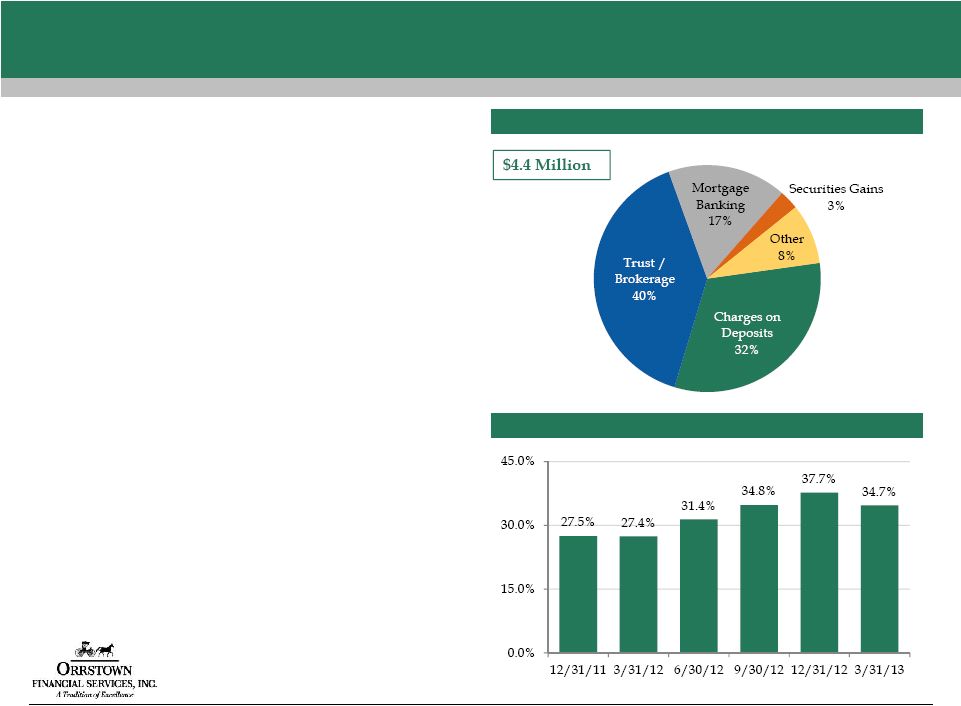 10
Diverse and Growing Revenue Stream
2013Q1 Noninterest Income Composition
•
Non-interest income continues to be
a stable and significant source of
revenue
•
Mortgage banking favorably
influenced by continued low interest
rate environment and greater
stability in the real estate market
•
Orrstown Financial Advisors
continues to generate solid trust and
brokerage revenue
•
Overall, favorable market conditions,
combined with new business
opportunities has led to an enhanced
revenue stream
Noninterest Income / Total Revenue (%)
(1)
1.
Note: noninterest income excludes gain on securities, total revenue
includes net interest income and noninterest income (excluding gain on securities) |
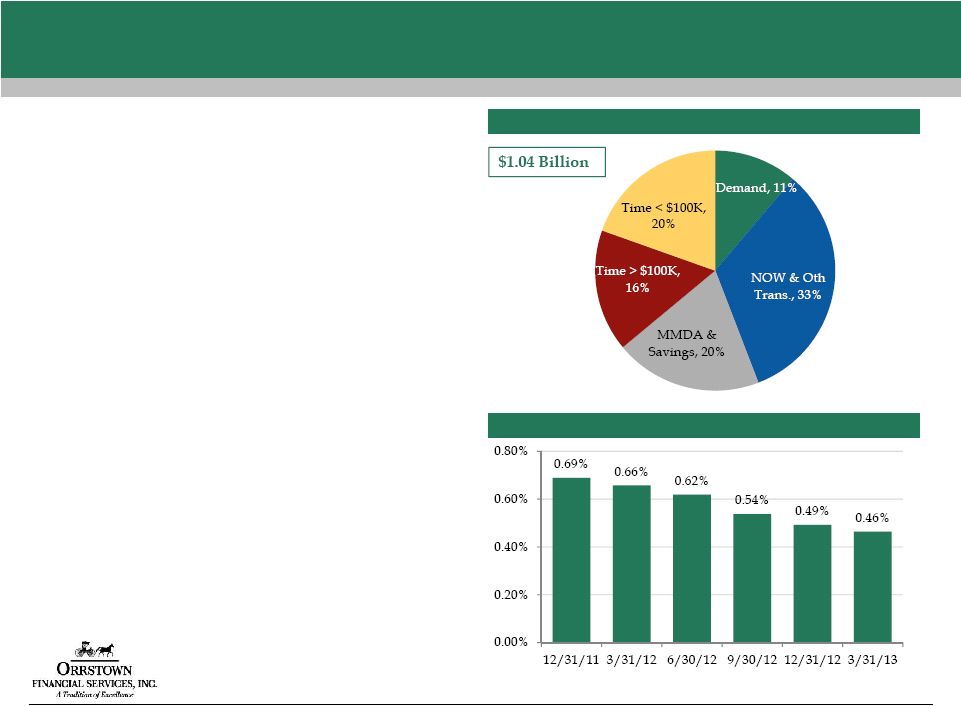 11
Deposit Franchise
Deposit Composition (3/31/13)
•
Significant deposit franchise -
with
over 83% “core “
•
Limited use of wholesale and
brokered deposits
•
Effectively managing the cost of
deposits which declined to 0.46% for
the quarter ended March 31, 2013
Cost of Total Deposits (%) |
 12
Capital Position
•
Regulatory Capital levels are solidly
above “well capitalized”
•
Simple capital structure –
no trust
preferred, TARP or holding company
debt
•
Common dividend was suspended in
2011 to preserve capital
•
Deferred tax valuation allowance of
$20.3 million taken in 2012 combined
with recent profitability implies future
potential upside to capital ratios
3/31/13 Capital Ratios (%) |
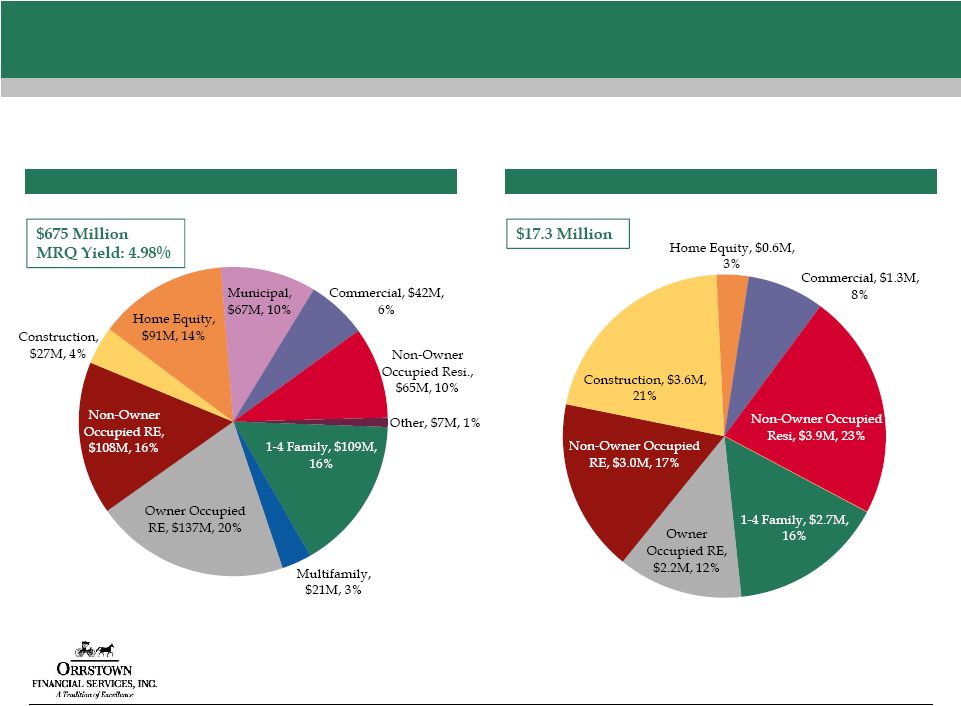 13
Diversified Loan Portfolio
Loans Held for Investment Composition (3/31/13)
Non-Performing Loans by Type
(3/31/13)
(1)
1.
NPLs include nonaccrual loans, restructured loans and still accruing,
loans past due 90 days or more and still accruing. |
 14
Aggressive Sale of Problem Assets
•
Fourth
quarter
2012
loan
sale
of
172
distressed
commercial
loans
with
a
book
balance
of
$45.6
million
significantly
reduced
non-performing
asset
levels
•
OREO
exits
have
balanced
capital
considerations
as
well
as
substantial
“soft
costs”
in
holding
NPA Inflows Continue to Slow
Future CRE and A&D will be Limited and Targeted
Strong Reserve Coverage
•
The
allowance
for
loan
losses
totaled
$21.9
million
at
March
31,
2013,
or
approximately
3.3%
of
gross
loans
and
127%
of
NPLs
Completing Credit Turnaround
Significant Reduction in NPAs
•
Asset quality issues were addressed quickly and
aggressively in 2012
•
“Risk Assets”
totaled $19.2 million at March 31,
2013, a 83% reduction from $113.8 million at
December 31, 2011
•
Risk Assets to assets of 1.61% as of March 31,
2013 is now in-line with peers and more
comparable to pre-crisis levels
•
Renegotiated loans (or “TDRs”) substantially
“cured”
in 2012
Note: Non-Performing assets defined as nonaccrual loans, restructured
loans and still accruing, loans past due 90 days or more and still accruing, and real estate owned. |
 15
Shareholder Focus –
ROI /Accretion
New Markets
Loan Production Offices and Full Service Branches
Branch Franchise Acquisitions
Whole Company Mergers
Each initiative will meet return on capital minimums
Transitioning to Offense -
Expansion Opportunities
•
Targeting attractive adjacent
markets
•
Expansion market customer base
allows for targeted line of business
growth |
 16
Investment Highlights
Established South Central Pennsylvania bank
Deep and experienced Management team with strong operational ability
Aggressively dealt with asset quality issues, with ratios that are now
in-line with peers as a result of 2012 strategies
Strategic plans in place to drive core earnings growth, with a return to
profitability in
the
fourth
quarter
of
2012
and
sustained
profitability
in
the
first
quarter
of
2013
Well-positioned for future growth throughout the region
Compelling absolute and relative valuation |
 Appendix |
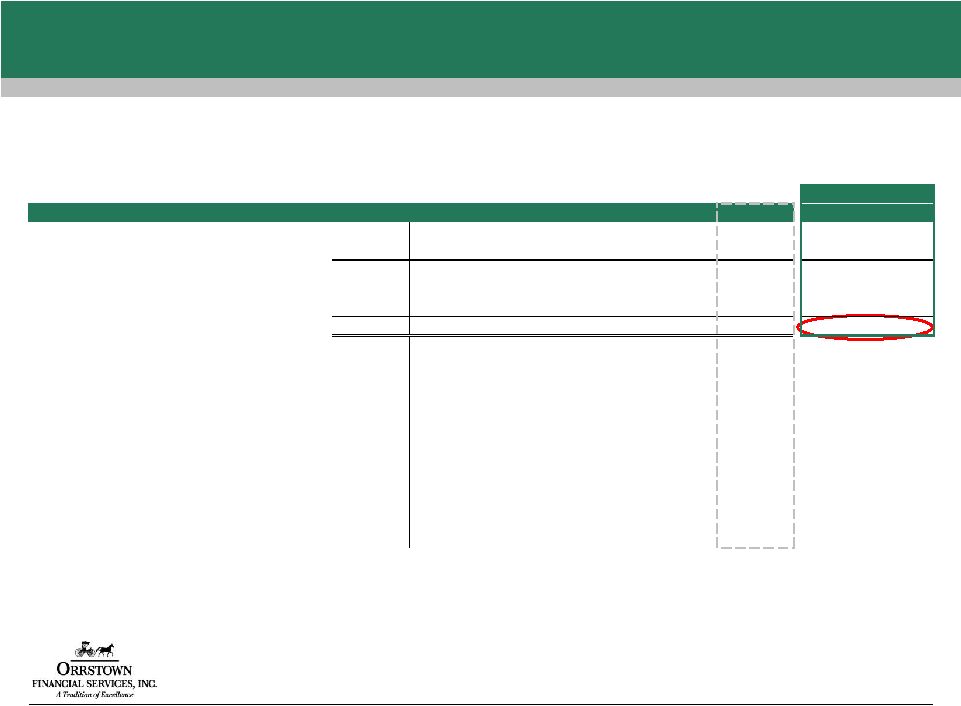 18
Non-Performing Asset Summary
1.
Non-Performing Assets = Nonaccrual + OREO.
2.
“Risk Assets”
= Nonaccrual + Restructured and still accruing + 90 day past due and still
accruing + OREO. % Change Q1'13 vs.
(dollars in thousands)
12/31/11
3/31/12
6/30/12
9/30/12
12/31/12
3/31/13
Q1'12
Q4'12
Non-Accrual Loans
83,697
$
82,058
$
56,917
$
57,780
$
17,943
$
14,220
$
(83%)
(21%)
OREO
2,165
2,413
2,337
2,575
1,876
1,925
(20%)
3%
Non-Performing Assets
85,862
$
84,471
$
59,254
$
60,355
$
19,819
$
16,145
$
(81%)
(19%)
Restructured Loans Still Accruing
27,917
3,844
2,831
3,113
3,092
3,078
(20%)
(0%)
90+ Days Delinquent Still Accruing
-
2
1,275
923
-
-
(100%)
NA
Total "Risk Assets"
113,779
$
88,317
$
63,360
$
64,391
$
22,911
$
19,223
$
(78%)
(16%)
Loans 30-89 Past Due
6,723
$
6,501
$
6,219
$
5,435
$
3,578
$
6,069
$
Asset Quality Ratios:
Non-Accrual Loans / Loans
8.67%
9.13%
6.79%
7.19%
2.55%
2.11%
NPAs/Assets
(1)
5.95%
5.84%
4.46%
4.75%
1.61%
1.35%
NPAs /Loans + OREO
8.87%
9.37%
7.05%
7.49%
2.81%
2.39%
"Risk Assets" /Loans + OREO
11.76%
9.80%
7.54%
7.99%
3.25%
2.84%
"Risk Assets"/Assets
(2)
7.88%
6.10%
4.77%
5.07%
1.86%
1.61%
Allowance for Loan Losses/ Loans
4.53%
3.13%
4.32%
4.57%
3.29%
3.25%
Allowance for Loan Losses/ Non-Accrual Loans
52.2%
34.3%
63.7%
63.5%
129.1%
154.1%
Allowance for Loan Losses/ Non-Accrual + Restructured
39.2%
32.8%
60.6%
60.3%
110.1%
126.7% |
 19
Asset Quality Trends
NPAs (Incl. TDRs) & 90+PD / Assets
(1)
Allowance for Loan Losses / Loans
Allowance for Loan Losses / NPLs
(2)
NCOs / Avg. Loans
Source SNL Financial, Peers consist of 19 exchange traded institutions
headquartered in the Mid-Atlantic with assets between $1.0 and $2.0 billion.
1.
Non-Performing
Assets
=
Nonaccrual
+
Restructured
and
still
accruing
+
90
day
past
due
and
still
accruing
+
OREO.
2.
Non-Performing Loans = Nonaccrual + Restructured and still accruing +
90 day past due and still accruing. |
